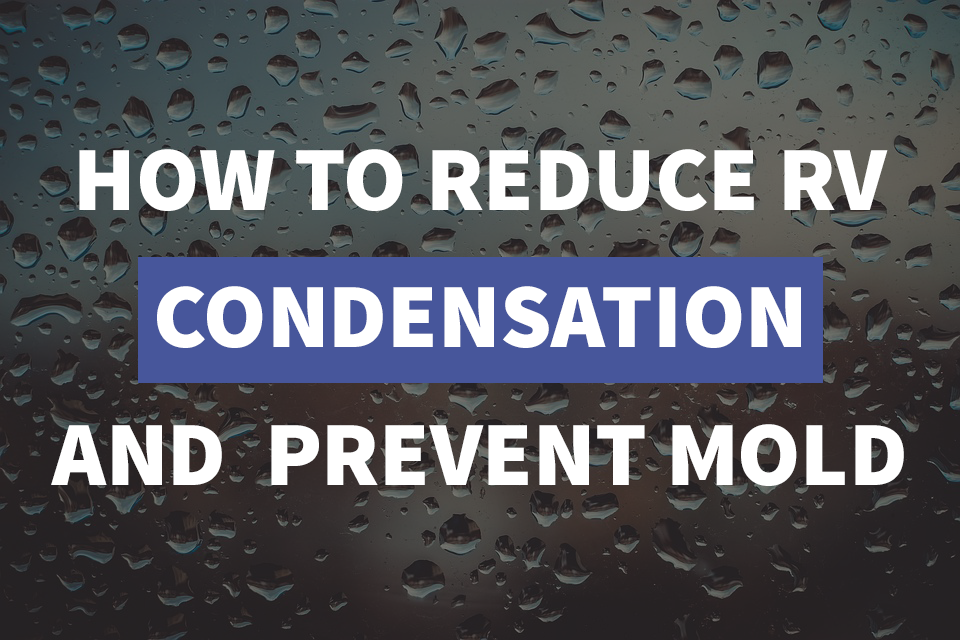
The formation of condensation can occur when camping in cold temperatures or in areas where there is a high level of humidity in the air. These water droplets will form on a variety of surfaces inside the RV, including the windows, walls, and countertops. It is important to keep RV condensation under control; otherwise your RV may be at risk of developing a mold problem. In addition to mold growth and its health issues, a buildup of condensation can also cause wood rot and corrosion. All of these can affect the overall look, performance, and value of your RV.
There are many tips we have learned from seasoned RVers when it comes to the formation of condensation. Here are some of the ones we have discovered work best:
Eliminate the RV Condensation Source
There are many different moisture sources inside your RV that you can control, which will help reduce the formation of RV condensation. For example, heating up food releases water vapors into the air and increases humidity levels. When cooking, make sure to cover all pots and pans to reduce water vapors escaping. Also, hang wet clothes outside to dry instead of inside. This way, the water vapors from the fabric do not get caught inside your RV.
Increasing Inside Temperature
The formation of RV condensation increases at a lower temperature. If possible, run the thermostat a little warmer in your RV. This will help reduce the levels of condensation inside the unit. A programmable RV digital thermostat can assist with climate control.
Installing Window Insulation
Do-it-yourself window insulator kits are available at home improvement and RV supply stores. Once installed, there will be a barrier between the window and the humid air, reducing the formation of condensation.
Using a Dehumidifier
Regularly using a dehumidifier inside your RV unit will help rapidly reduce the levels of humidity without increasing the temperature. There are small, compact dehumidifiers that are designed specifically for camping.
Ventilating the Unit
Properly ventilate your RV. This ensures that water vapors in the bathroom after showering and in the kitchen when cooking get released outside. Some RV goers suggest cracking a window for a few minutes to help even out the moisture content in the air inside the unit.
Wiping Surfaces
When you see RV condensation starting to form on windows and countertops, take the time to wipe it away immediately.
Preventing Mold Growth
To prevent mold from growing inside your RV, it’s best to keep the humidity levels between 30 and 50 percent. Humidity meters, also known as a hygrometer, are available to purchase and install inside your RV to help keep track of moisture levels in the air. Some dehumidifiers are equipped with meters to help monitor humidity levels.
By using any of the above listed tips, or all of them combined together, you will be able to keep RV condensation formation down to a minimum and reduce your chances of having mold grow and causing damage to your unit. No condensation or mold will increase the amount of fun you have on the road.
Related links:
What To Do About A/C Condensation
Tips for RV Air Conditioner Maintenance
6 Tips for Hot Weather RVing
Do I have an electric water heater
We found dri rot, what do you do?
Any suggestions for eliminating the condensation on the fresh water tank after I fill it with COLD well water ? I first noticed the surrounding rug was wet. Now the plywood flooring is getting wet . I plan on using roofing paper to protect the wood and then encasing the tank in black rubber insulation. I'm sure this problem in wide spread in all RVs.
THE BEST SMALL DEHUMIDIFIER TO USE IN A 20 FOOT MOTORHOME WITH TWO PEOPLE LIVING INSIDE IN THE U.K.
Trying to find the corner peaces on the motor home located on the slide outs. Tried to attach a picture but there's no spot to add a picture of what I'm talking about. They're like plastic caps on the corner of the slide out
I have a 33 ft class A motor home i recently purchased with 37k miles, as for condensation I use moisture collectors and so far they seem take in the moisture and keeps a dry coolness.
We are full timers living in a motor home. Currently in Maine for the winter, our windscreen is the biggest problem and in temps below freezing has ice and condensation. Running a fan directly onto the windscreen and leaving a gap under the blind for air to circulate has cut down 99% of that problem.
We’re in South Houston 19 miles from Galveston, humidity and heat are nasty 6-8 months of the year. We’ve been running a GE dehumidifier at 50% RH and installed wireless hygrometers to track the moisture level. The enclosed storage facility helps some with exposure, and this system seems to work.
Anyone know much about a 1978 Red Dale motor home
Leaving rig for the first time in Florida for the summer. Any tips on “summerizing” to prevent mold, mildew and sun damage.